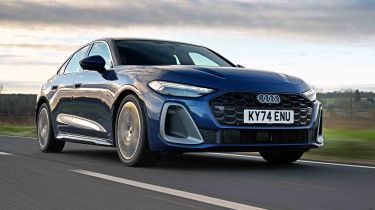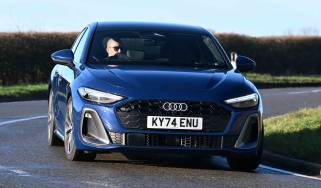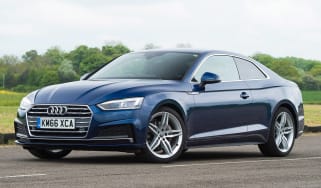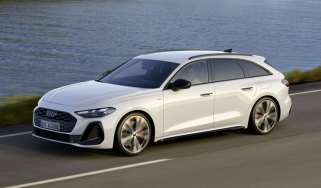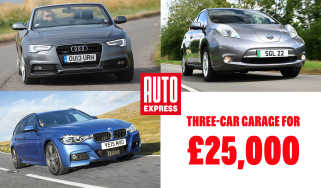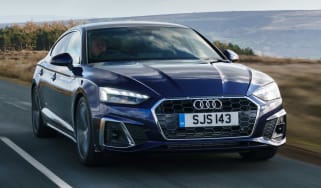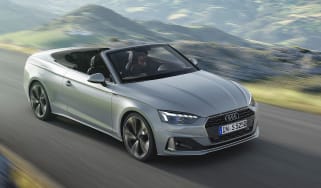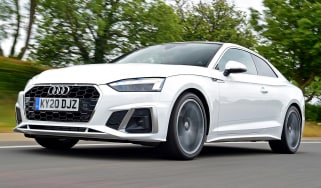Audi A5 review
The Audi A5 is a bigger, smarter, plusher (and pricier) replacement for the A4 that’s competent to drive

Our opinion on the Audi A5
The latest Audi A5 replaces the old A4 saloon and Avant, as well as the various incarnations of the old A5. It’s bigger and better finished inside than any of its predecessors, but it’s also much more expensive.
The experience behind the wheel won’t tempt keen drivers, but the A5 doubles down on being a high-quality, solid and sensible car with smart looks and better legroom (although not headroom) for rear passengers. It’s also more practical than the old A4, thanks to having a hatchback tailgate rather than the restrictive letterbox-style opening of a traditional saloon car.
It’s a shame efficiency doesn’t make a big leap in the petrol cars, but the plug-in hybrids offer a fine mix of performance and efficiency if you can afford one. To a large extent, the A5 is a case of ‘meet the new boss, same as the old boss’.
| Key specs | |
| Fuel type | Petrol, diesel, plug-in hybrid |
| Body style | Hatchback, estate |
| Powertrain | 2.0-litre, 4cyl turbocharged petrol, front-wheel drive 2.0-litre, 4cyl turbocharged diesel, front-wheel drive 2.0-litre, 4cyl turbocharged diesel, four-wheel drive 3.0-litre, 6cyl turbocharged petrol, four-wheel drive |
| Safety | 5-star (Euro NCAP, 2024) |
| Warranty | 3yrs/60,000 miles |
About the Audi A5
You’re going to have to bear with us for a second, because while the car you see here is the replacement for the Audi A4 saloon, it’s also very much not the new Audi A4 saloon. The change from A4 to A5 was necessary to differentiate between Audi’s EVs and internal combustion-engined cars – although the Audi brand has since backtracked on this model naming strategy. It was to be that all ICE (internal combustion engine) models would use odd numbers, so the A4 needed to become A5.
Used - available now
Going forward, electrified versions will continue to use the E-Tron moniker, just as TDI refers to a diesel engine and TFSI refers to a petrol engine. The repurposing of the A5 name means a few of the old A5 models, such as the Sportback and Coupé, are gone forever. The A5 is now only available as a ‘saloon’ or an Avant estate.
To make things more complicated, the A5 Saloon is actually a hatchback, and is very similar to the old A5 Sportback. So if you’re in the market for something like the old A4 saloon, the A5 is your only option. It remains to be seen whether the A4 name, which has been around since it replaced the Audi 80 in 1994, will return when the brand reveals an electric compact executive saloon in a few years’ time.
Admittedly, the A4 has diminished in importance in Audi’s range in recent years, as the move to SUVs has eaten into the popularity of saloons and estates. Even with the discontinued Coupé, Sportback, and Cabriolet A5, the A4/A5 models as a whole were no better than the sixth-biggest sellers in Audi’s UK line-up.
The latest car comes with a choice of two 2.0-litre petrol engines, with 148bhp or 201bhp, or a 201bhp diesel. The diesel is the only model offered with a choice of front-wheel drive or quattro all-wheel drive because the 295bhp e-hybrid plug-in hybrid option is quattro only. There’s also a hot 362bhp S5, and a range-topping plug-in hybrid RS 5 will be added in the future.
All A5s get a seven-speed S tronic automatic gearbox, while the diesel was the first TDI to get hybrid tech. The MHEV+ system can run the car in electric-only mode for very short distances, and Audi says this improves official emissions by up to 10g/km. The e-hybrid plug-in models arrived a little after the car’s initial launch with 142mpg official economy and a 67-mile EV range that will appeal to company car buyers.
The two petrol cars have claimed economy figures of up to 42.8mpg, depending on spec, while the diesel returns up to 58.9mpg. The price gap between the 201bhp petrol engine and the identically powered diesel unit is more than £4,000. If you jump from the diesel to an equivalent plug-in hybrid, it’s £3,750.
The A5 has grown and is larger than the BMW 4 Series Gran Coupé, the car’s most logical rival. Prices have also increased to match its new stature, and while you get a bigger car – around 70mm longer, 24mm taller and 13mm wider – a step up on what was already a nice cabin, and a lift in standard kit, it’s still quite a price hike.
How much does the Audi A5 cost?
As you might have already deduced, going up one number from A4 to A5 means that pricing across the board has seen a bit of an increase, because the A5 starts at around £42,000, jumping to a little over £44,000 for the mid-range S Line. Push the boat out for the top-of-the-range Edition 1, and you’ll need to fork out just over £49,000.
The e-hybrid plug-in hybrid models are offered in an entry-level Technik trim to keep costs down, and these models start from under £50,000. The Sport trim, which is the entry point elsewhere in the range, starts from around £51,500 in e-hybrid guise. The Avant estate bodystyle comes in at £1,900 over the saloon prices.
Our network of trusted dealers is currently offering discounts on the recommended retail price of the Audi A5 via our Find a Car service. Alternatively, you can lease an A5 or buy a used A5, all on Auto Express.
Performance & driving experience

| Pros |
|
| Cons |
|
The brand claims to have worked on the Audi A5 to give it a more engaging driving experience compared with its sensible and borderline forgettable A4 forbear, but we’re not convinced much has changed.
Our drives through the French mountains, on German roads around Munich, and here in the UK on a mix of different road conditions, reveal that the car continues to tread the centre ground between its two premium German rivals. The BMW 3 Series offers a more responsive and dynamic feel, while the Mercedes C-Class has a slight edge in terms of comfort.
Engine options are less numerous than previously but cover the important bases, with the obvious exception of a pure-electric variant. The A5 is offered in two power outputs of the 2.0-litre TFSI petrol – 148bhp and 201bhp – or with the 201bhp TDI diesel, which can be had with either front-drive or quattro four-wheel drive.
Plug-in hybrid customers are offered a 295bhp e-hybrid system based on the 2.0-litre petrol engine, but not the 362bhp variant that’s available in Europe. All the e-hybrids have quattro all-wheel drive.
Finally, there’s the sporty S5 that launched alongside the A5. This uses a 3.0-litre TFSI petrol engine with 362bhp. An even sportier RS 5 is in the pipeline.
Performance, 0-60mph acceleration and top speed
The fastest-accelerating engine option in the standard A5 range is the plug-in hybrid. With 295bhp and all-wheel drive, it can cover the 0-62mph blast in 5.9s and hit a 155mph top speed. The all-wheel-drive diesel can do 0-62mph in 6.9 seconds, taking 0.8 seconds less to cover the sprint than the front-drive version.
The 201bhp petrol engine gets the A5 from 0 to 62mph in 7.8 seconds, then on to a 154mph top speed. That’s a tenth shy of the front-wheel drive diesel, and the figure increases to 9.8 seconds for the 148hbhp petrol, which can reach 134mph.
The S5 is the quickest version until an RS 5 emerges. 0-62mph takes 4.5 seconds, and it’ll bump into Audi’s 155mph limiter with ease. The performance figures for the Avant estate models are largely the same as for the saloon.
On the road, the A5’s 201bhp petrol or diesel options both feel adequate without being too punchy. Much like the rest of the A5, they are refined and do the job with minimal fuss, but don’t stand out for responsiveness or clout.
The plug-in hybrid is an impressive piece of kit with the petrol and electric power sources well integrated and able to work together almost seamlessly. Clever tech reads the driving conditions and the planned route to optimise the system’s performance. The result is that it feels powerful when you need it to, and relaxed when you don’t.
Town driving, visibility and parking
The A5 isn’t perfect at ironing out bumps and ripples in the road, but if anything, it’s the smaller imperfections that transmit most annoyingly into the cabin. Bigger speed bumps are dispatched with minimal fuss, but the car doesn’t always absorb the smaller stuff around town. That is on the larger wheels and sports suspension of the S Line and Edition 1 models that we tested, however. We suspect that the regular Sport on 18-inch alloys will provide a more comfortable ride, although that car hasn’t yet been made available for testing.
The seven-speed automatic gearbox is smooth and does its work without drawing attention to itself. The light steering is also at its best in lower-speed manoeuvres.
Rear visibility isn’t great, with the sloping hatchback window not being particularly large, and not having a rear wiper will be a handicap when the weather gets colder and wetter. The Avant estate version is better in this respect, but regardless, all A5s are equipped with a 360-degree camera and rear camera, as well as Audi’s parking-assist tech.
B-road driving and handling
Despite Audi’s attempts to make the A5 more engaging, the pecking order still places the car below the BMW 3 Series in terms of driver engagement and enjoyment.
There’s nothing particularly wrong with how the Audi drives; it’s just a very safe and solid companion that doesn't feel like it has any sort of edge to it. Where the BMW would at least make like it’s enjoying a twisting section of road with its lively responses and chassis poise, the Audi deals with things in a slightly disengaged way. Much of that is due to the feel and weight of the steering, which is lovely around town, however, out onto faster roads, that lightness shifts from a positive to a negative. A bit more weight and overall feeling of connection wouldn’t go amiss.
If you’re not after thrills from your compact executive car, though, then the Audi is a great all-rounder that feels solid and sure-footed with plenty of traction, even if you don’t go for the quattro four-wheel drive that’s only available with the diesel engine.
One thing to note is that, due to its hybrid system, the diesel has a less pleasant feel to the brake pedal. Petrol cars have progressive action, but the diesel feels like you’re almost instantly up against resistance in the brake pedal travel, making it harder to modulate and gradually feed in the stopping power.
The plug-in hybrids don’t suffer from this, but they do employ a clever system where the steering wheel paddles control gearshifts in hybrid mode but then switch to control the strength of the regenerative braking when you choose EV mode. None of the brake re-gen settings are particularly strong, but it’s a nice touch that makes the e-hybrid feel more like an EV.
Motorway driving and long-distance comfort
Motorway driving is the Audi A5’s most natural environment, and the car does a good job of keeping out road and wind noise. The high-quality interior can be appreciated as you settle into a longer cruise, and the screens are nicely angled toward the driver, creating a cockpit-like ambience.
The higher-powered petrol and sole diesel - both with 201bhp - are better options than the 148bhp petrol for anyone regularly on longer runs. The diesel is much pricier to buy, though, so you’ll need to be doing big miles to make the extra efficiency pay back.
The e-hybrid plug-in models are more expensive again but acquit themselves well on longer journeys. Refinement is very good when cruising, and if you put your foot down, you’ll either get a muted snarl from the petrol engine or a slight whine from the electric motor, depending on the selected driving mode.
| Model | Power | 0-60mph | Top speed |
| TFSI 150PS | 148bhp | 9.8s | 134mph |
| TFSi 204PS | 201bhp | 7.8s | 154mph |
| TDI 204PS quattro | 201bhp | 6.9s | 150mph |
| e-hybrid quattro | 295bhp | 5.9s | 155mph |
“The neatest part of the A5’s PHEV set-up is the efficiency-boosting intelligent hybrid system. In Hybrid mode, the car assesses driving conditions and the navigation route data to optimise the mix of petrol and electric power…” Steve Walker, head of digital content, who drove the A5 e-hybrid in Germany.
MPG, emissions & running costs

| Pros |
|
| Cons |
|
The Audi A5 engine line-up differs from the BMW 3 Series in that Audi has retained a sole diesel option. The diesel will have great appeal for higher-mileage drivers, thanks to its official WLTP combined economy figure of up to 58.9mpg, depending on factors such as wheel size and specification. That drops back to 55.3mpg if you want the quattro four-wheel drive car, but compares well with a best of 42.2mpg for both the 148bhp and 201bhp petrol engines.
That’s broadly in line with rivals such as the 3 Series and BMW 4 Series Gran Coupe, with the, admittedly slightly less powerful, 184bhp petrol cars around 1mpg above the Audi on the official test. The 1.5-litre 204bhp petrol engine in the Mercedes C 200 saloon, meanwhile, is about another mile per gallon better on top. You can’t buy a 3 Series diesel any more, but you can still get either a C 220 d or C 300 d in the Mercedes C-Class. The most efficient C 220 d with 197bhp is more efficient than Audi’s diesel, with a consumption figure of 62.8mpg.
The A5 diesel uses new mild-hybrid technology that can run the car for short distances on electric power and otherwise gives an efficiency boost. If you want a more comprehensive hybrid experience, though, you’ll want the e-hybrid plug-in A5, which delivers a WLTP combined efficiency of 142mpg. The e-hybrid models (which are all four-wheel drive) also return 43.5mpg when the battery is flat, 3.5mpg better than the equivalent BMW 330e plug-in hybrid. There is a slight fuel economy penalty for choosing the Avant estate across the range.
| Model | MPG | CO2 | Insurance group |
| TFSI 150PS S Line | 42.8mpg | 154g/km | 24E |
| TFSi 204PS S line | 42.8mpg | 155g/km | 31E |
| TDI 204PS S Line | 58.9mpg | 127g/km | 33E |
| e-hybrid quattro 299PS S Line | 141.9mpg | 45g/km | 39E |
Electric range, battery life and charge time
The A5 e-hybrid models have a 20.7kWh (usable) battery that powers an electric motor integrated into the S tronic automatic gearbox. This gives an impressive electric range of 67 miles, which is better than the BMW 330e but worse than the 71-mile Mercedes C 300 e. You might think that a few miles here or there could be made up by careful driving, but these official figures determine the company car tax band of the car, and by getting over 70 miles, the Mercedes accesses a cheaper tax bracket.
Charging is AC only, with no option to rapid charge, which is odd considering the less expensive Volkswagen Passat has the ability to be rapid charged. If you charge your plug-in hybrid A5 from a 7.4kW home wallbox, a full charge will take just under four hours
| Model | Battery size | Range | Insurance group |
| e-hybrid quattro Saloon S Line | 20.7kWh | 67 miles | 39E |
| e-hybrid quattro Avant S Line | 20.7kWh | 65 miles | 40E |
Tax
Predictably, no versions of the A5 duck under the £40,000 threshold for luxury car tax, so all suffer from higher annual Vehicle Excise Duty from the second time the vehicle is taxed until it is six years old. Given that there isn’t an electric A5, there isn’t a version that is positioned to evade charges in low-emission zones that benefit electric cars.
The e-Hybrid plug-in hybrids are going to be the best choice for company car drivers, unless very high mileage or lack of access to charging forces them into a diesel. The 67-mile electric range puts the cars into a nine per cent Benefit-in-Kind tax bracket for the 2025/26 tax year, but the Mercedes C 300 e can do more than 70 miles, so it is taxed on six per cent of its value.
Insurance groups
The A5 is likely to be one of the more affordable mid-size company cars around to insure, with the least powerful petrol starting in group 24, which is four places lower than the equivalent 3 Series and nine places below the C-Class.
For the time being, it should also be less costly to insure than electric alternatives such as the BMW i4 starting in group 35, and the Tesla Model 3 beginning in group 36.
The plug-in hybrids are more costly to insure due to having a more complicated drivetrain of both an engine and an electric motor, plus a battery pack. These e-hybrid cars range from group 38 to 40, depending on spec.
Depreciation
The A5 holds its value well, with the Saloon version maintaining between 42 to 49 per cent and the Avant being worth between 44 to 50 per cent over a typical three-year/36,000-mile ownership period.
The BMW 3 Series is slightly ahead (46 to 52 per cent for the saloon and 47 to 53 per cent for the Touring), while the Mercedes C-Class is further back (42 to 47 per cent for the saloon and 44 to 49 per cent for the Estate). The BMW is also the cheapest of the three, and is predicted to be worth the same as the Audi after three years and 36,000 miles, despite the Audi starting a few thousand pounds more expensive.
To get an accurate valuation for a specific model, check out our free car valuation tool...
Interior, design and technology
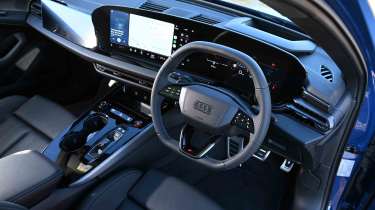
| Pros |
|
| Cons |
|
While the Audi A5 looks quite sensible and grown up in terms of its exterior and interior design, there’s nothing revolutionary about its styling (apart from it now being called A5 rather than Audi A4). However, that does mean you still get all the bits the A4 always excelled in.
So cabin quality is excellent and everything is laid out logically, including the much-appreciated physical volume knob for the audio system. As in most cars, too much is now controlled through the touchscreen, but the more buttons that remain, the better.
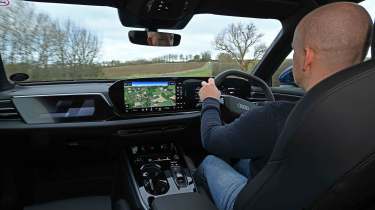
Interior and dashboard design
The dashboard is dominated by a long curving arc that’s actually formed by two separate displays, and there’s plenty of squishy surfaces, gloss plastic trim and nice lighting to show it’s a high-class place to be.
Too many controls work through the touchscreen, but that at least cleans up the front area that would previously have housed the more user-friendly but less aesthetically pleasing rotary controls and other buttons. Standard spec is a round steering wheel that feels noticeably larger than the BMW 3 Series’ more compact device, but above the entry-level Sport trim, you get a much nicer wheel that’s flattened off top and bottom.
Materials and build quality
Everything feels high in quality, from the squishy dashboard top and fabric across the full width of the car to the rubber-lined front door bins that stop anything from making a noise rolling around. The silver air vents on either side of the cabin and beneath the big screen increase the appearance of premium effort.
Sat-nav, stereo and infotainment
The two large screens that dominate the cabin are a 14.5-inch curved touchscreen central display angled towards the driver, and an 11.9-inch digital instrument cluster that offers a range of functionalities and is controlled by touch-sensitive buttons on the steering wheel. If anything, the buttons are over-sensitive, and on several occasions during our test drive, we accidentally activated the audio system while cornering.
It’s a shame so many buttons have been removed from the cabin - it’s not a quick press to switch driving modes when you spot a series of bends coming up, for example. The menu system is logically laid out, but like all touchscreens, it isn’t easy enough to use when you’re on the move. At least a little click tells you your prod has been accepted by the system, meaning a touch less time with eyes off the road.
The standard audio system offers crisp enough sound for most, but if you’re an aural connoisseur, there is a pricey Sound & Vision option pack that brings a Bang & Olufsen upgrade complete with speakers embedded into the car’s headrests.
Audi’s app now allows A5 drivers to set the climate control and open or close windows remotely, as well as check location and fuel levels.
Unlike the A4, the A5 will be able to receive over-the-air updates to the infotainment system, for example, while various apps such as Amazon Music and YouTube can be installed into the infotainment system, and Apple CarPlay and Android Auto are present.
Not to be overlooked, and only fitted to the top-spec Edition 1 models, is a third screen. Mounted ahead of the front passenger, the 10.9-inch touchscreen is a bit of a novelty for a while, but having an extra nav or trip computer display isn’t massively useful, although Audi says its tech can stream content away from the driver's prying eyes. We’re unsure which screen wins when driver and passenger disagree about the radio station or navigation destination.
Boot space, comfort & practicality
| Pros | Cons |
|
|
As mentioned previously, in calling the Audi A5 a Saloon, Audi is being slightly disingenuous, due to the hatchback design of the car. The hatch is actually more practical than a saloon’s letter-box style opening when it comes to fitting big loads in. It is a shame that no rear windscreen wiper is fitted to the A5 (you’ll have to go for the A5 Avant for that), because you’ll either have to break out the bucket and sponge more often in winter in order to see what’s behind you, or rely on the standard front and rear parking sensors and reversing camera - which actually do a very good job.
All A5 Saloons are five-seaters, while there is also the Avant estate model. Audi no longer sells an A5 Sportback, Coupe or Cabriolet.
Dimensions and size
The A5 is notably larger than the A4 saloon it replaces, and the over 70mm of extra length is mainly between the wheels, making for a more spacious cabin area.
The increase in size also puts the A5’s footprint well clear of the BMW 3 Series or BMW 4 Series Gran Coupe, and the Mercedes C-Class, and the Audi is also taller than any of its rivals, although you feel like you’re sitting quite low down when you drop into the driving seat.
| Dimensions | |
|---|---|
| Length | 4,829mm |
| Width | 1,860mm |
| Height | 1,444mm 1,460mm (Avant) |
| Number of seats | 5 |
| Boot space | 445 litres, 417 litres (quattro), 448-476 litres (Avant) |
Driving position, seats & space in the front
Though the front of the car feels wide and spacious for passengers, there’s not a great amount of storage. Under the movable armrest there’s a fairly shallow space, and you get a pair of cup-holders and a wireless charging pad in the centre, as well as two USB-C chargers. But that’s about it. The door bins are lined and have a reasonable depth, but it’s not a car where you’re going to forget where you’ve stashed your sweets.
It is comfortable, though. The front seats are big and welcoming, if lacking a tiny bit in lateral support, but it’s not a problem to spend hours in them on a long run.
Seats & space in the back
Back-seat passengers used to sacrificing some comfort sitting in the rear of compact executive models of old will be delighted to learn that it’s they who most benefit from the A5’s increased size over its predecessor. Legroom is significantly better compared with the old A4 – or any of the other premium German competitors – and rear passengers get their own ventilation control, as well as a pair of USB-C chargers and a fold-down armrest.
But the news isn’t all good if you carry taller passengers, because the sloping roofline has a predictable impact on rear headroom. And although the width has increased over the A4, three passengers in the rear will have to be good friends. Choose the Avant estate if you’ve got taller people to fit in the rear because it has a little more headroom.
The rear door pockets aren’t lined as they are in the front, which smacks of cost-cutting to us. Two ISOFIX points are provided on the outer positions of the rear seat, and are accessed by removing a couple of conveniently located plastic tabs.
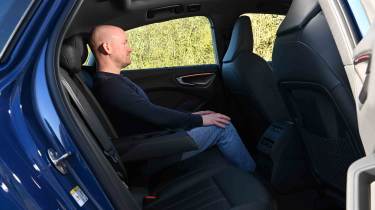
Boot space
Unlike the rear-seat space and despite the A5’s growing dimensions, its boot capacity hasn’t grown over previous Audi compact execs; in fact, it’s smaller, at 445 litres, dropping to 417 in the A5s with quattro all-wheel drive. The A4 saloon was 15 litres better than the front-drive A5, while the BMW 3 Series can offer 500 litres in total, and the Mercedes C Class has up to 480 litres of luggage capacity.
The A5 Avant estate is no larger than the saloon, but it does gain a little boot space, going up to 476 litres depending on the specification.
The hatchback design is more practical than the traditional saloon boot still favoured by rivals, though. The small decrease in overall volume is countered by a wider opening, which offers better access than a saloon, especially for bulkier or heavier loads. There is a small lip to lift things over, and the boot is quite long and wide, but shallow rather than being particularly deep.
There’s also nothing particularly clever about the load area. It features a couple of plastic hooks, a 12V socket, and a luggage net, but lacks underfloor stowage or any neat compartments for hiding smaller items.
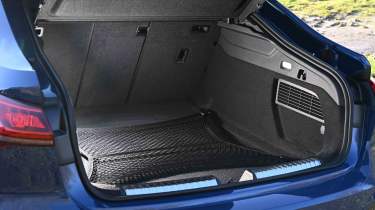
All versions of the A5 come with a handy 40:20:40 split folding rear seat. In the regular A5, dropping the rear seats has to be done from the back door rather than the boot, whereas the Avant estate model features a more convenient lever at the rear of the car. The seats at least go pretty much completely flat, which helps when sliding in longer items. Folding the seats opens up 1,299 litres of space (which is exactly the same as the BMW 4 Series Gran Coupe) or 1,271 litres on quattro models. In the Avant, there’s up to 1,424 litres with the seats down, depending on the version.
Towing
The S6 performance model actually has the best towing capacity at 1,900kg, but the quattro TDI diesel cars are within a well-packed suitcase of that figure at 1,885kg and will be significantly more economical. The e-hybrids manage around 1,700kg, and the base front wheel drive petrol A5s are rated to tow 1,500kg.
Expert view, on practicality
“Audi’s decision to call the 5-door hatchback A5 a ‘Saloon’ is certainly confusing, but the large tailgate opening is undoubtedly better for practicality. You get far more options for cramming things in, but it also means you don’t gain as much by choosing the Avant estate.” - Steve Walker, head of digital content, who tested the A5 ‘Saloon’ and Avant in Germany
Safety & reliability
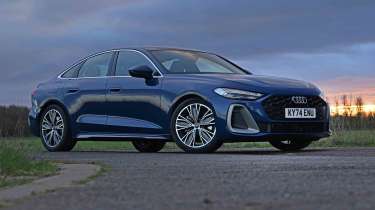
| Pros |
|
| Cons |
|
Safety experts Euro NCAP have awarded the Audi A5 the maximum five-star rating. Direct comparisons between the 3-Series and C-Class can’t be made because these rivals were tested under earlier, less stringent testing criteria, but against electric alternatives, the Volkswagen ID.7 scored better in all categories, while the BYD Seal did better in the adult and child occupancy categories, and had a higher vulnerable road user protection result.
Standard safety kit on all cars includes adaptive cruise control, lane-departure warning and intersection, turn and swerve assist, as well as front and rear parking sensors and 360-degree and rear-view cameras. However, only the top Edition 1 models come with lane-change assist, a top-down camera display, and the proactive passenger-protection system that preempts an accident and primes the car’s safety systems.
The outgoing Audi A4 finished quite a long way down our Driver Power rankings of the 50 best cars according to owners. It ranked 44th, with its reliability rating a couple of positions lower, although owners rated it highly for value and for economy and running costs. In our 2024 manufacturer rankings, the Audi brand ranked 27th out of 32 manufacturers, while its archrival BMW placed 14th.
| Key standard safety features |
|
| Euro NCAP safety ratings |
|
Buying and owning
- Best buy: Audi A5 e-hybrid quattro Saloon S Line
Audi still offering a diesel engine in the A5 will be attractive to some buyers, but we think the optimum engine choice is the e-hybrid plug-in version. Assuming you can afford the extra outlay of £3,750 over the oil-burner, it should deliver the goods in terms of low running costs and is a no-brainer for company car drivers. The petrol options are solid but forgettable.
The S Line models are very popular across Audi’s range because of the more dynamic looks. It’s a decent value package that adds a lot, but the larger wheels probably don’t help ride quality. The Audi A5 Avant estate doesn’t offer as much of a practicality benefit as it did due to the Saloon now having a hatchback tailgate, so it might come down to whether you prefer the estate car look or not.
Audi hasn’t yet put out details of the service schedule for the A5, but its cars are available with flexible servicing, which is up to 18,600 miles or two years, depending on the car’s sensors assessing the oil degradation. But on some models, Audi offers a one-year or 9,300-mile oil service, and an inspection service every two years or 18,600 miles.
Audi pledges to price-match on service, repair, maintenance or new tyres, on any quote that includes Audi genuine parts.
Audi A5 alternatives
While the mid-size company car market has been gravitating away from the traditional saloon car body style, there are still the usual suspects in the BMW 3 Series and Mercedes C-Class to contend with. The C-Class has a wide choice of engines, from mild-hybrid petrol and diesel options, plus a plug-in hybrid with a long electric-only range. The 3 Series still has the edge over the A5 in terms of the driving experience, though.
It’s hard to argue with the latest range of electric cars – especially if you are a company car driver paying Benefit-in-Kind (BiK) tax. Of the various choices available, it's the Tesla Model 3 that gets our nod, but the BMW i4 isn’t far behind (if you can afford its hefty list price), while the Volkswagen ID.7 provides a big battery with a usefully long electric range.
You can buy an Audi A5 or any of its key rivals through our Find A Car service. Just configure your car and get offers from dealers, or choose a new model from stock for a fast delivery.
Deals on the Audi A5 and alternatives
Audi A5 pictures
Frequently Asked Questions
We really like what Audi has done with the A5, it’s big, roomy and feels like a thoroughly high quality product. Practicality is improved by the hatchback on the ‘Saloon’ model, but the overall amount of boot space isn’t the biggest. It’s also not the most thrilling car in the class to drive, feeling predictable and secure rather than particularly dynamic.
